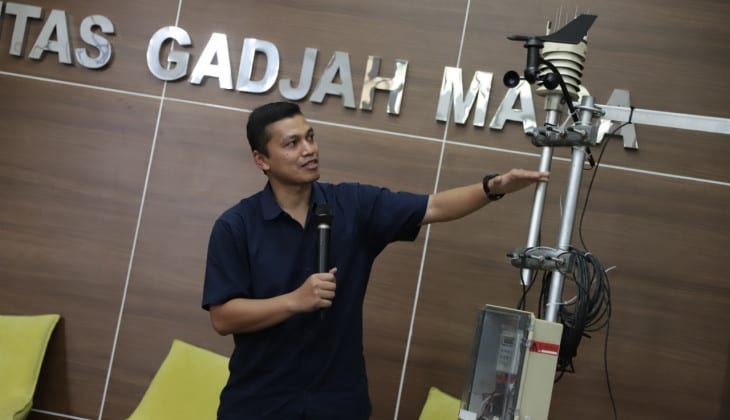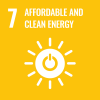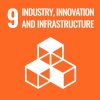
The technology was developed by lecturer of the Department of Agricultural and Biosystem Engineering, Bayu Dwi Apri Nugroho, Ph.D. This technology can calculate methane (CH4), carbon dioxide (CO2), and ammonium (NH4) levels produced in agricultural lands.
Bayu said that so far the development of smart agriculture has always been oriented to precision farming or on-farm. Meanwhile, data obtained from sensors installed on agricultural land can actually be used to calculate other information outside of on-farm, including calculating greenhouse gas emissions.
“So far, the calculation of greenhouse gas emissions on agricultural land has been done manually and estimates have been based on secondary data such as the types of variety and fertilizer, and then referenced to the guidelines from the Intergovernmental Panel on Climate Change (IPCC). But in reality, produced carbon emissions may exceed the prediction,” he said to reporters during a press conference done in Fortakgama room UGM on Monday (16/12).
The agriculture sector, said Bayu, is one of the contributors to greenhouse gases. Greenhouse gas emissions contributed from the agricultural sector are around 24 percent and tend to increase from year to year. In the last 50 years there has been an increase in greenhouse gases from the agricultural sector by almost 100 percent. In 1961 this sector contributed greenhouse gases of 2.7 billion tons of CO2 and experienced a significant increase in 2012 to 5.4 billion tons of CO2. The main sources of greenhouse gas emissions from the agricultural sector come from conventional agriculture which uses chemical fertilizers and excess irrigation, the use of unfermented fertilizers, and massive burning of straw on agricultural land.
Agricultural sector, according to Bayu, is one of the contributors to greenhouse gas emissions, or around 24 percent which is increasing from year to year. In the last 50 years there has been an increase in greenhouse gases from the agricultural sector by almost 100 percent. In 1961 this sector contributed greenhouse gases of 2.7 billion tons of CO2 and experienced a significant increase in 2012 to 5.4 billion tons of CO2. The main sources of greenhouse gas emissions from the agricultural sector come from conventional agriculture which implements chemical fertilizers and excess irrigation, unfermented fertilizers, and massive burning of straw on agricultural land.
Seeing this condition, Bayu made a calculation by using the data from sensors in real time and updates, such as data related to climate, ground parameters, and plant growth. These data can be used to evaluate irrigation systems and calculate the concentrations of greenhouse gas emissions.
Through this technology data can then be obtained to calculate the emission from the telemetry. Furthermore, it is processed with an artificial neural network model (ANN) to reduce the emission value in the land.
This technology is built with 5 sensors in the field monitoring system (FMS), namely pyranometer, anemometer, humidity and temperature, rain, and soil humidity (including temperature and electrical conductivity of the ground). It is equipped with Em50 data logger to store the data. There is also a telemetry that functions to send data from the data logger to an automatic server every day using a modem from telecommunication providers. A camera is also installed to monitor rice and a solar panel to generate power.
Bayu said the technology works when all sensors are connected to the data logger. Measurement is done automatically every 30 minutes and data will be directly stored. A field router will retrieve the data every day and send it to the server via GSM internet network. The field router will also send photos of the location once a day.
“Users can access all data in the form of numerical data, graphics or images or photos through an already developed website,” he said.
This innovation was developed since 2016 and has been piloted at the SRI rice cultivation demonstration plot in Kupang District, NTT in collaboration with the Indonesia Climate Change Trust Fund / ICCTF BAPPENAS. Next in the 2018 period applied in East Sumba Regency, NTT and the development of FMS in the demonstration plots in Banjarnegara and Purbalingga with funding from the Higher Education Research Consortium, RISTEKDIKTI.
This innovation has been developed since 2016 and piloted at the SRI rice cultivation demonstration plot in Kupang District, East Nusa Tenggara, in collaboration with Indonesia Climate Change Trust Fund/ICCTF BAPPENAS. In 2018 this technology was applied in East Sumba and FMS in demonstration plots in Banjarnegara and Purbalingga with funding from the Higher Education Research Consortium, RISTEKDIKTI.
The development of IoT smart farming is expected to support the low carbon building in the country, especially in agriculture. Moreover, the government has stipulated that provinces ought to report their greenhouse gas emission calculations.
The development of IoT-based smart agriculture is expected to support low-carbon building in the country, especially in agriculture. Moreover, the government has stipulated that provinces ought to report their greenhouse gas emission calculations.
“Hopefully, this technology helps achieve environmentally friendly agriculture with precision farming that puts forth efficiency in using information to make decisions,” he said.
He also hoped it would benefit farmers by making it easier for them to carry out farming activities and increasing agricultural productivity through the use of a planting calendar and the right cropping patterns as well as lower production costs. (UGM Public Relations / Ika; photo: Firsto)



